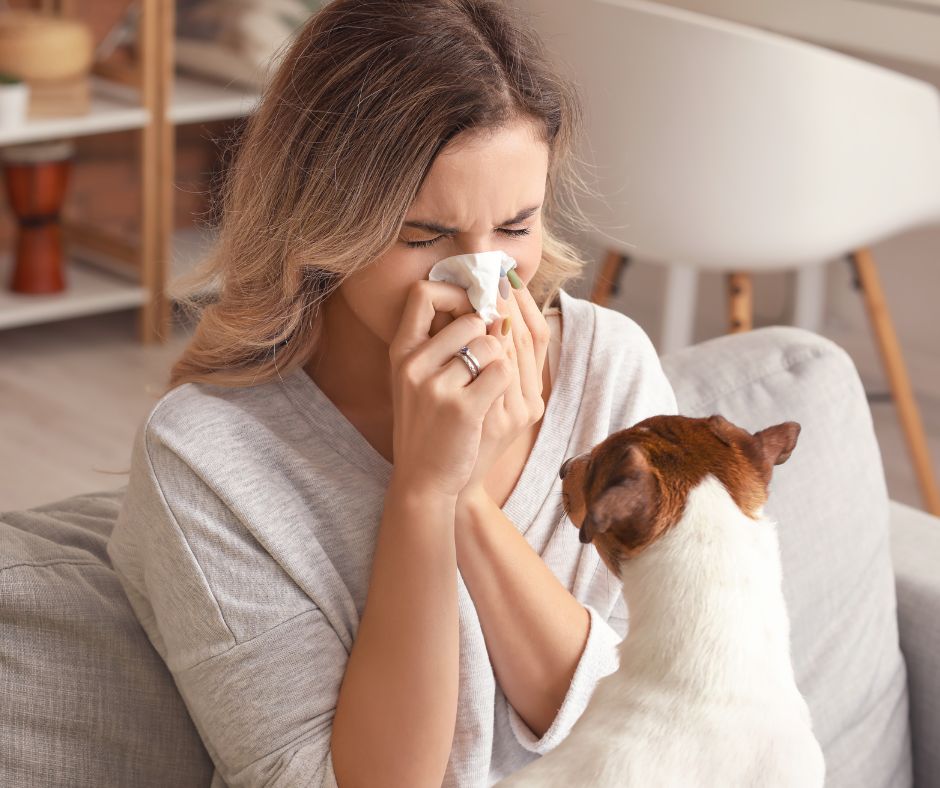It’s National Pet Week, a time to celebrate and give some love to our purrfect pet companions. But if you’re one of the millions of Americans with pet allergies, celebrating this particular week may give you paws.
We get it–sneezing and sniffling is no fun. But if being a pet parent is something you wish, you don’t have to let allergies tread on your furry fun. With a few simple tips and tricks, you can still enjoy the company of a four-legged friend without the stress of serious allergy symptoms.
The ABCs of Pet Allergies
First, let’s talk about the basics of pet allergies. Believe it or not, you shouldn’t fear the fur. That’s because people with pet allergies aren’t actually allergic to a pet’s hair (or fur, or feathers). Pet allergies are caused by an overreaction of the immune system to proteins found in an animal’s skin cells (dander), saliva, or urine. All pets produce these allergy-inducing proteins whether they have hair or not (which is why there’s no such thing as a hypoallergenic dog.)
When exposed to these proteins, people with pet allergies experience a wide range of symptoms. The most common pet allergy symptoms include a stuffy nose, sneezing, itchy eyes, and skin rashes. Some people have very minor symptoms while others experience more severe reactions, especially those with asthma or other lung conditions.
But that doesn’t mean pet hair plays no role in allergy symptoms. Pet hair collects dander as skin cells are shed and carries it through the air, where it easily enters your eyes, nose, and mouth. Pet hair can also house other common allergens like dust mites and pollen. For this reason, hairless or non-shedding pets can be a friendlier option for people with pet allergies.
Living with a Pet and Allergies
If you have a pet allergy, the easiest course of action is to avoid close contact with animals. But if that’s not an option, there are steps you can take to reduce your exposure and minimize your symptoms. Here are a few tips to keep in mind:
- Keep your home clean. Regular cleaning can help remove pet dander, saliva, and other allergens from your home. Use a HEPA filter vacuum on floors and fabrics frequently and wash your pet’s bedding regularly (at least once per week). You should also change your air filters on a regular basis to reduce airborne allergens in your home.
- Keep your pets clean and well-groomed. Bathe and brush your pet regularly to help reduce shedding and remove any other allergens they’re carrying around. Be sure to clean the area and yourself well after grooming.
- Designate pet-free zones. Create no-pet zones in areas of your home where you spend the most time. Keep pets out of your bedroom and off of the furniture, and consider installing a HEPA-approved air filter in these areas.
- Consider medications. If you’re struggling with pet allergies, over-the-counter antihistamines and nasal sprays may be effective at reducing your daily symptoms. Always talk to your doctor before starting any new medications.
- Try Immunotherapy. Unlike old dogs and new tricks, you can train your body to adapt to pet allergies. Allergy immunotherapy involves gradually exposing you to small amounts of allergens to build up your tolerance. Our sublingual allergy drops are a form of immunotherapy that provides effective relief with just a few drops under your tongue each day. Visit us online and contact our team to learn more!

